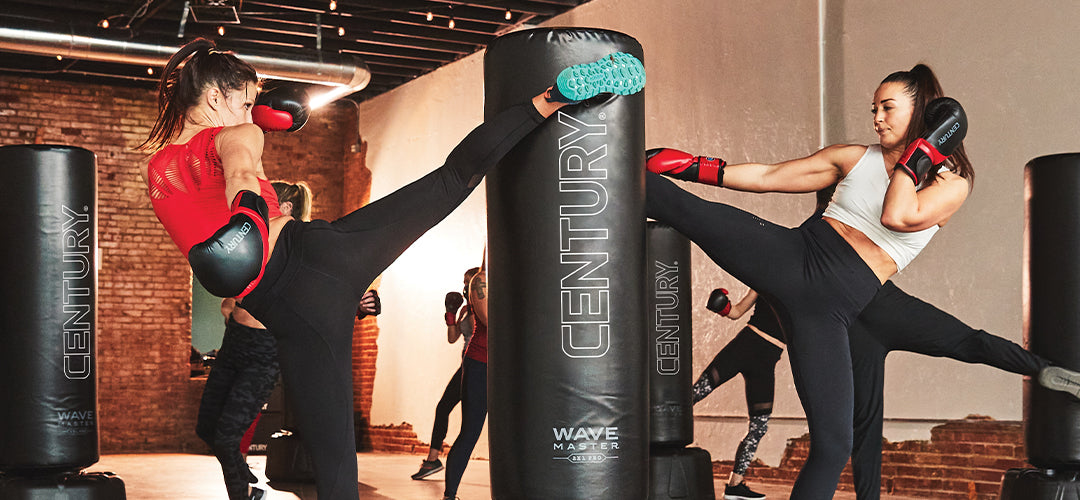HOW DO I FIT A CARDIO BAG CLASS INTO MY GYM?

When it comes to adding a cardio boxing/kickboxing class, the biggest hindrance to some fitness studio or gym owners may not be the cost of equipment or a lack of staff, but lack of space. The size of the training bags (ranging 80-270 lbs.) seems intimidating. Where will they be stored? How much floor space will they take up? Will they get in the way of other classes?
These concerns prevent some gym owners from adding what could otherwise be a highly successful bag-based cardio class to their schedule. The reality is, you can set up a cardio boxing or kickboxing class, bags and all, and still have space leftover! Here’s how:
Step 1) Assess your current classes.
You may be worried about a new class, especially one with large equipment, “crowding out” your existing classes. This is a fair concern – the last thing you want to do is have your cardio bags class be perceived as an inconvenience to participants of your existing class. Excitement, not annoyance, needs to be the dominant emotion people associate with your new class.

Examine the classes you offer now, and what space they use. Do you offer a barre class, where the space around the walls is the most important? Do you have yoga, where participants need space to roll out their mats in the center of the room, facing an instructor? Or do you run a boot-camp class, where participants run all over the room? Are spare mats and weights stored in closet, or alongside one wall?
Make sure you understand the layout of your current classes, then start looking at potential bags.
Step 2) Find the best arrangement based on your space.
Once you have a full understanding of the space your current classes use, you can start thinking about where you’d put bags when they’re not in use. Here are a few examples, based on the previously listed scenarios:
• If you have a barre class, or any class where it is essential that participants lining the room can see a central instructor, you should store your bags in corners of your room. For maximum space efficiency, you can build them out in a triangle shape: one tucked into corner as far as possible, then two pressed against it, then three, and so on. You should be able to store a large number of bags this way without impeding anyone’s view.
• If you offer a yoga class, where space in the center of the floor is important, you could store the bags alongside one wall. This could be a side or back wall, depending on the length/width of the room. Make sure the side you choose leaves plenty of space in the center.
• If you have a boot camp class, especially one that has participants move around the room, you have several options. Of course, you can push the bags against a wall or into a corner – wherever they will be least in the way. You can also incorporate one or multiple bags into your boot camp class; for example, by having one bag set up as a station for punches, another for kicks, another for toe-taps around the bag, and so on.
NOTE: You may have noticed that all of these scenarios use freestanding (mobile) rather than hanging heavy bags. This is because, from a fitness gym perspective, freestanding bags are much more practical. If you plan on using hanging heavy bags you will need to devote considerably more permanent space to your cardio boxing/kickboxing class. This is true whether you plan to mount them from the walls, ceiling, or on individual heavy bag stands. For this reason, we highly recommend you use freestanding bags.
Step 3) Determine the number of bags you’ll need.
Let’s say you plan to offer a cardio kickboxing class, and you’ve decided to use Wavemaster 2XL Pro bags. You’ve asked around, and determined that 12 people are interested. Do you need 12 bags?
The baseline answer is seven. The 2XL Pro is large enough that two people can work on it at once—punching opposite sides or even alternating kicks (carefully!). If you want to be on the safe side, ordering eight bags will give you an extra two spaces for additional participants.

On the flip side, smaller bags like the Cardio Wavemaster and Versys V.1 can only be used by one participant at a time. You will either need more, or you’ll need to set up a circuit training class where bags are only one or two stations.

You may have visited other gyms to get a sense of how they use their space, but if you haven’t, here are some real-life examples of what other gyms, studios, and boutiques are doing:
What it is: A group fitness class boutique.
Where it is: Nine locations in the Las Vegas area, Arizona, Missouri, Oregon and California.
Average arrangement: 1,000-1,500 square feet, 10-16 bags, and two people per bag
What it is: A full-service health club with a group fitness studio for classes.
Where it is: 110 locations in 26 states.
Average arrangement: 2,000 – 2,500 square feet, 8-10 bags, and one or two people per bag depending on the bag type and attendance
What it is: A full-service health club with a group fitness studio for classes.
Where it is: 80 locations in seven states.
Average arrangement: 2,000 – 2,500 square feet, around 20 bags, and two people per bag
What it is: A group fitness class boutique.
Where it is: One location in North Miami Beach and another in Fort Lauderdale.
Average arrangement: 2,500 square feet, 15-20 bags, and two people per bag
What it is: A group fitness class boutique.
Where it is: One location in Ham Lake, Minnesota
Average arrangement: 3,150 square feet, 30 bags, and one or two people per bag
What it is: A cardio kickboxing studio
Where it is: Multiple locations in Iowa.
Average arrangement: 7,000 square feet, 60 bags, with two people per bag
These facilities use about 100 square feet per two-person bag. That’s a good rule of thumb to follow when you start determining which area of your facility you will designate for your bags class.



